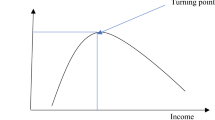Abstract
In this paper we address the problem of estimating of Municipal-level of Mexican economic activity indicators (IAEM in Spanish) by using different data sources. We build on the preliminary estimations of López-Pérez and Corona (Real Datos Espac Rev Int Estad Geogr 1(3):102–123, 2020), however because of the shortcomings of standard data sources, such as national accounts and economic censuses, in terms of update frequency, this study enhances preliminary estimations with nighttime lights data. We rely on the statistic relation between economic activity with nighttime lights intensity, and the uncorrelatedness of the latter with the measurement error in the preliminary estimations to produce an estimate of true economic growth, as has been described, among others, in and Mendoza (Empir Econ 57(3):971–990, 2019). Our results are interesting in three ways: (i) develops a practitioner's guide for estimating IAEM for all Mexican municipalities since 1993, (ii) for users and analysts of economic information provides detailed results of economic activity evolution for some municipalities, (iii) represent a novel application pursuant Big Data in economics framework.



Similar content being viewed by others
Notes
This function is programmed in R language and is available upon request.
References
Bickenbach F, Bode E, Nunnenkamp P, Söder M (2016) Night lights and regional GDP. Rev World Econ 152:425–447
Chen Z, Yu B, Yang C, Zhou Y, Yao S, Qian X, Wu J (2021) An extended time series (2000–2018) of global NPP-VIIRS-like nighttime light data from a cross-sensor calibration. Earth Syst Sci Data 13(3):889–906
Corona F, López-Pérez J (2019) Obteniendo indicadores de actividad económica municipal basados en información representativa de los Censos Económicos. Real Datos Espac Rev Int Estad Geogr 10(2):62–81
Dagum EB, Cholette PA (2006) Benchmarking, temporal distribution, and reconciliation methods for time series. Lecture Notes in Statistics, vol 186. Springer, New York
Donaldson D, Storeygard A (2016) The view from above: applications of satellite data in economics. J Econ Perspect 30:171–198
Galimberti JK (2020) Forecasting GDP growth from outer space. Oxford Bull Econ Stat 82(4):697–722
Galindo MF (2021) Estimación del Grado de Marginación en México utilizando imágenes satelitales y aprendizaje profundo (MSc dissertation, Universidad Nacional Autónoma de México)
Gómez MF (2021) Estimación del Grado de Marginación en México utilizando imágenes satelitales y aprendizaje profundo (PhD thesis, Universidad Nacional Autónoma de México)
Guerrero VM, Mendoza JA (2019) On measuring economic growth from outer space: a single country approach. Empir Econ 57(3):971–990
Guerrero VM, Peña D (2003) Combining multiple time series predictors: a useful inferential procedure. J Stat Plan Inference 116(1):249–276
Henderson JV, Storeygard A, Weil DN (2012) Measuring economic growth from outer space. Am Econ Rev 102:994–1028
Hsu F-C, Baugh KE, Ghosh T, Zhizhin M, Elvidge CD (2015) DMSP-OLS radiance calibrated nighttime lights time series with intercalibration. Remote Sens 7(2):1855–1876
Hu Y, Yao J (2022) Illuminating economic growth. J Econom 228(2):359–378
IMCO (2020) Medición de la Actividad Económica con Grandes Datos 2020. Online June 2021: https://imco.org.mx/medicion-de-la-actividad-economica-con-grandes-datos-magda-2/
INEGI (2015) Indicadores por entidad federativa. https://www.inegi.org.mx/app/estatal/
Li D, Zhao X, Li X (2016) Remote sensing of human beings—a perspective from nighttime light. Geo Spatial Inf Sci 19(1):69–79
Li X, Zhou Y, Zhao M, Zhao X (2020) A harmonized global nighttime light dataset 1992–2018. Sci Data 7:168. https://doi.org/10.1038/s41597-020-0510-y
Llamosas-Rosas I, Rangel González E, Sandoval Bustos M (2021) Medición de la actividad económica en las principales zonas turísticas de playa en México a través imágenes satelitales. Ensay Rev Econ 40(2):115–136
López-Pérez J, Corona F (2020) Indicadores de actividad económica municipal 1993–2013. Real Datos Espac Rev Int Estad Geogr 11(3):102–123
Organización para las Naciones Unidas, Comisión Europea, Organización para la Cooperación y Desarrollo Económico, Fondo Monetario Internacional y Banco Mundial (2009) Sistema de Cuentas Nacionales 2008. Organización para las Naciones Unidas. https://unstats.un.org/unsd/nationalaccount/sna2008.asp
Rangel-González, E., and Llamosas-Rosas I (2019) An alternative method to measure non-registered economic activity in Mexico using satellite nightlights. Working paper https://www.imf.org/-/media/Files/Conferences/2019/7th-statistics-forum/session-iii-gonzalez.ashx
Sahoo S, Gupta PK, Srivastav SK (2020) Inter-calibration of DMSP-OLS and SNPP-VIIRS-DNB annual nighttime light composites using machine learning. Giosci Remote Sens 57(8):1144–1165
Funding
Elio Atenógenes Villaseñor acknowledges the partial financial support to "GEO-GEE License Program" for the infrastructure provided to the project “Vulnerable Settlements” for the acquisition and processing of geospatial data.
Author information
Authors and Affiliations
Corresponding author
Ethics declarations
Conflict of interest
Francisco Corona declares that he has no conflict of interest. Elio Atenógenes Villaseñor declares that he has no conflict of interest. Jesús López-Pérez declares that he has no conflict of interest. Ranyart Rodrigo Suárez declares that he has no conflict of interest.
Ethical approval
This article does not contain any studies with human participants performed by any of the authors.
Additional information
Publisher's Note
Springer Nature remains neutral with regard to jurisdictional claims in published maps and institutional affiliations.
Appendix A: IAEM for selected municipalities
Appendix A: IAEM for selected municipalities



Note: Upper panels annual percentage variations, lower IAEM. The solid green line are the preliminary series, the red dotted line estimates with luminosity. Source: Own elaboration by the authors.
Rights and permissions
Springer Nature or its licensor (e.g. a society or other partner) holds exclusive rights to this article under a publishing agreement with the author(s) or other rightsholder(s); author self-archiving of the accepted manuscript version of this article is solely governed by the terms of such publishing agreement and applicable law.
About this article
Cite this article
Corona, F., Villaseñor, E.A., López-Pérez, J. et al. Estimating Mexican municipal-level economic activity indicators using nighttime lights. Empir Econ 65, 1197–1214 (2023). https://doi.org/10.1007/s00181-023-02376-z
Received:
Accepted:
Published:
Issue Date:
DOI: https://doi.org/10.1007/s00181-023-02376-z
Keywords
- True economic activity
- Big data
- Economic censuses
- Municipal-level economic activity indicators
- Nighttime lights




